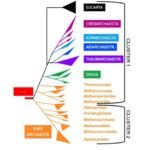Lien vers Pubmed [PMID] – 25964353
Proc. Natl. Acad. Sci. U.S.A. 2015 May;112(21):6670-5
One of the most fundamental questions in evolutionary biology is the origin of the lineage leading to eukaryotes. Recent phylogenomic analyses have indicated an emergence of eukaryotes from within the radiation of modern Archaea and specifically from a group comprising Thaumarchaeota/”Aigarchaeota” (candidate phylum)/Crenarchaeota/Korarchaeota (TACK). Despite their major implications, these studies were all based on the reconstruction of universal trees and left the exact placement of eukaryotes with respect to the TACK lineage unclear. Here we have applied an original two-step approach that involves the separate analysis of markers shared between Archaea and eukaryotes and between Archaea and Bacteria. This strategy allowed us to use a larger number of markers and greater taxonomic coverage, obtain high-quality alignments, and alleviate tree reconstruction artifacts potentially introduced when analyzing the three domains simultaneously. Our results robustly indicate a sister relationship of eukaryotes with the TACK superphylum that is strongly associated with a distinct root of the Archaea that lies within the Euryarchaeota, challenging the traditional topology of the archaeal tree. Therefore, if we are to embrace an archaeal origin for eukaryotes, our view of the evolution of the third domain of life will have to be profoundly reconsidered, as will many areas of investigation aimed at inferring ancestral characteristics of early life and Earth.


